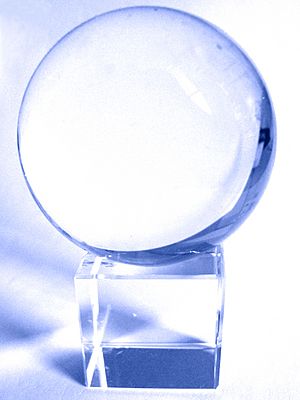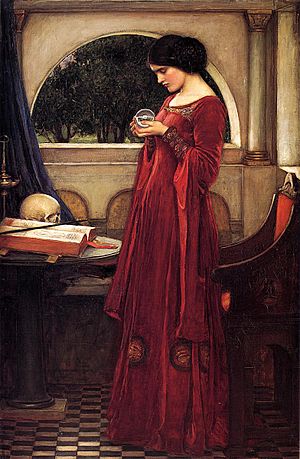Crystal ball facts for kids
A crystal ball is a round ball, usually made of crystal or glass. Many people think of it as a special object used for fortune-telling, which is a way of trying to predict the future. It's often linked to a practice called scrying, where people try to see visions.
Today, crystal balls are also popular for creative photography. They are sometimes called "lensballs" because they can act like a special camera lens, bending light to create interesting photos.
Contents
The Art of Scrying
The practice of trying to "see" things in a crystal ball is called scrying. People who scry believe they can see images or get messages from the crystal. They then try to understand what these images mean.
This "information" might be used to help them make choices about their life, like love, money, or travel. When scrying is done specifically with crystals or other clear objects, it's known as crystallomancy or crystal gazing.
Crystal Balls in Magic Shows
Crystal balls are also very popular props for stage magicians, especially in acts called "mentalism". In these shows, the magician might pretend to answer questions from the audience using the crystal ball.
One famous magician from the 1900s, Claude Alexander, was known as "Alexander the Crystal Seer" because of his crystal ball acts. He used clever tricks to make it seem like he could see the future.
How Crystal Balls Work (and Safety Tips)
A crystal ball is like a very round lens. Because it's clear and curved, it can bend light rays. This means it can focus sunlight into a very bright, hot spot.
If a large crystal ball is left in direct sunlight, it can act like a burning glass. The focused sunlight can get hot enough to burn your hand if you're holding it. It can even start a fire if it's placed near flammable things, especially dark-colored materials. So, it's important to be careful and never leave a crystal ball in direct sunlight.
See also
 In Spanish: Bola de cristal para niños
In Spanish: Bola de cristal para niños



